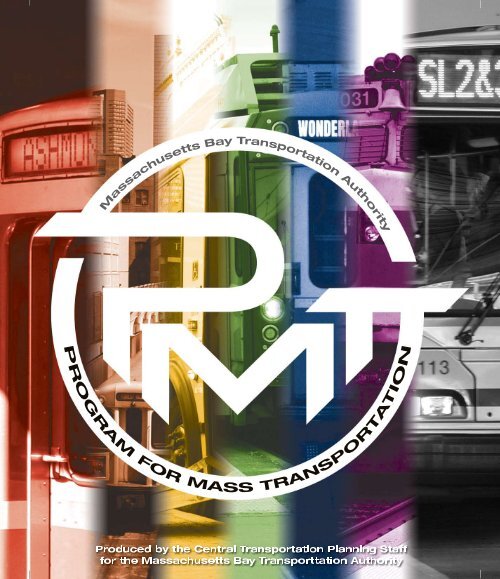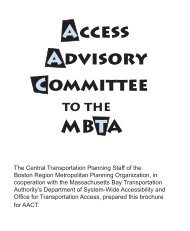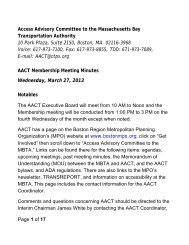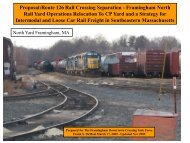Cover, title page, acknowledgements and table of contents
Cover, title page, acknowledgements and table of contents
Cover, title page, acknowledgements and table of contents
You also want an ePaper? Increase the reach of your titles
YUMPU automatically turns print PDFs into web optimized ePapers that Google loves.
Produced bythe CentralTransportationPlanning Staff<br />
forthe MassachusettsBayTransporttationAuthority
THE PROGRAM FOR MASS<br />
TRANSPORTATION<br />
Ma s s a c h u s e t t s Ba y Tr a n s p o r t a t i o n Au t h o r i t y<br />
Deval Patrick, Governor<br />
Tim Murray, Lieutenant Governor<br />
Jeffrey B. Mullan, Secretary <strong>of</strong> Transportation <strong>and</strong> CEO, Massachusetts Department <strong>of</strong> Transportation<br />
William A. Mitchell, Jr., Acting General Manager, Massachusetts Bay Transportation Authority,<br />
<strong>and</strong> Acting Rail <strong>and</strong> Transit Administrator, MassDOT<br />
Project Managers<br />
Joseph M. Cosgrove, Director <strong>of</strong> Planning <strong>and</strong> Development, MBTA<br />
Elizabeth M. Moore, Manager <strong>of</strong> Transit Service Planning, CTPS<br />
Contributors<br />
Sree Allam<br />
Jonathan Belcher<br />
Annette Demchur<br />
Ben Dowling<br />
Robert Guptill<br />
Ian Harrington<br />
John Hersey<br />
Thomas J. Humphrey<br />
Kathy Jacob<br />
Bruce Kaplan<br />
Sanjay Kaul<br />
Maureen Kelly<br />
Grace King<br />
David Kruse<br />
William Kuttner<br />
Scott A. Peterson<br />
Alicia Wilson<br />
Cartography<br />
Kenneth A. Dumas<br />
Kathy Jacob<br />
<strong>Cover</strong> <strong>and</strong> Document Design<br />
Kate Parker-O’Toole<br />
Photography<br />
Carol Gautreau Bent<br />
Kenneth A. Dumas<br />
MBTA Marketing<br />
Kim Noonan<br />
The preparation <strong>of</strong> this document was supported by the Executive Office <strong>of</strong> Transportation <strong>and</strong> Public Works <strong>of</strong> the Commonwealth <strong>of</strong><br />
Massachusetts <strong>and</strong> by the Federal Transit Administration, through §5303 grants MA-80-0001, MA-80-0002, <strong>and</strong> MA-80-0003, <strong>and</strong><br />
MBTA Planning Contract X94PS23.<br />
Prepared for the Massachusetts Bay Transportation Authority by the Central Transportation Planning Staff.<br />
CTPS is directed by the Boston Region Metropolitan Planning Organization. The MPO is composed <strong>of</strong> state <strong>and</strong> regional agencies <strong>and</strong><br />
authorities, <strong>and</strong> local governments.<br />
December 2009
Ac k n o w l e d g m e n t<br />
The Massachusetts Bay Transportation Authority wishes to recognize the substantive contributions made by the Program<br />
for Mass Transportation Stakeholder Advisory Committee. This dedicated group <strong>of</strong> agency <strong>and</strong> community representatives,<br />
through its active engagement <strong>and</strong> pr<strong>of</strong>essional approach to deliberations, provided highly insightful guidance <strong>and</strong> useful<br />
input. Members’ commitment to developing a forward-looking regional vision <strong>and</strong> their ability to articulate the considered<br />
views <strong>of</strong> the organizations <strong>and</strong> public they represent was <strong>of</strong> great value in the development <strong>of</strong> this PMT. Many thanks are<br />
extended to each member organization <strong>and</strong> the representatives.<br />
William A. Mitchell, Jr.<br />
Acting General Manager, MBTA, <strong>and</strong> Acting Rail <strong>and</strong> Transit Administrator, MassDOT<br />
PMT Stakeholder Advisory Committee Members<br />
A Better City<br />
Thomas Nally<br />
Massachusetts Bay Transportation Authority<br />
Joe Cosgrove, Ron Morgan, Victor Rivas<br />
Access Advisory Committee to the MBTA<br />
Philip Beaulieu, James Oliver<br />
MBTA Advisory Board<br />
Paul Regan<br />
Blue Cross Blue Shield <strong>of</strong> Massachusetts<br />
Richard Page<br />
MBTA Rider Oversight Committee<br />
Karen Wepsic<br />
Boston Transportation Department<br />
Paul Christner, Vineet Gupta<br />
Massachusetts Institute <strong>of</strong> Technology<br />
Nigel Wilson<br />
Chelsea Collaborative<br />
T.J. Hellmann<br />
MassRIDES<br />
Kay Carson<br />
City <strong>of</strong> Medford<br />
Ken Krause<br />
Codman Square Neighborhood Development Corporation<br />
Marcos Beleche, Gail Latimore<br />
Executive Office <strong>of</strong> Housing <strong>and</strong> Economic Development<br />
Patrick Hart, Mark Siegenthaler<br />
Executive Office <strong>of</strong> Energy <strong>and</strong> Environmental Affairs<br />
Marc Breslow<br />
Executive Office <strong>of</strong> Transportation <strong>and</strong> Public Works<br />
Steve Woelfel<br />
Livable Streets Alliance<br />
Jeffrey Rosenblum<br />
Medical Academic <strong>and</strong> Scientific Community Organization<br />
(MASCO)<br />
Christi Apicella, Ulla Hester<br />
Metropolitan Area Planning Council<br />
Barbara Lucas<br />
Regional Transportation Advisory Committee<br />
Steve Olan<strong>of</strong>f<br />
Town <strong>of</strong> Acton<br />
F. Dore Hunter<br />
University <strong>of</strong> Massachusetts, Boston<br />
Steve Martinson, Susan Wolfson<br />
On November 1, 2009, the Commonwealth implemented a reorganization <strong>of</strong> its transportation agencies. This reorganization integrated<br />
transportation agencies <strong>and</strong> authorities into a new entity, the Massachusetts Department <strong>of</strong> Transportation (MassDOT). As <strong>of</strong> this date,<br />
MassDOT oversees four new divisions: Highway, Rail <strong>and</strong> Transit, Aeronautics <strong>and</strong> Registry <strong>of</strong> Motor Vehicles (RMV). All references<br />
throughout the PMT <strong>of</strong> future activities by the Executive Office <strong>of</strong> Transportation (EOT) will now refer to the new agency – MassDOT.
TABLE<br />
OF<br />
CONTENTS<br />
Contents<br />
Page<br />
In t r o d u c t io n<br />
ix<br />
Ch a p t e r 1 – Ch a l l e n g e s a n d Op p o r t u n i t i e s 1-1<br />
An Under-Funded Transit System with Significant Infrastructure Needs 1-1<br />
Environmental Concerns <strong>and</strong> Changing Growth Patterns 1-2<br />
Transit Capacity <strong>and</strong> Meeting Mobility Expectations 1-3<br />
System Accessibility for All 1-4<br />
Quality Customer Service 1-5<br />
Balancing Open Mobility with Safety <strong>and</strong> Security Concerns 1-5<br />
Equi<strong>table</strong> Distribution <strong>of</strong> Benefits <strong>and</strong> Burdens 1-6<br />
Ch a p t e r 2 – Pr o g r e s s Sin c e t h e La s t PMT 2-1<br />
Improving Service Reliability 2-2<br />
Reversing Deferral <strong>of</strong> System Infrastructure Preservation Needs 2-5<br />
Improving Customer Service: Cleanliness, Courtesy, Convenience, <strong>and</strong> Communications 2-8<br />
Making Transit Service Accessible to All 2-11<br />
Ensuring Safety <strong>and</strong> Security 2-14<br />
Instituting Best Management Practices 2-15<br />
Instituting New Technologies <strong>and</strong> Practices to Increase Energy Efficiency <strong>and</strong> Improve the Environment 2-16<br />
Enhancing <strong>and</strong> Exp<strong>and</strong>ing Service to Increase Ridership <strong>and</strong> Improve Regional Mobility 2-16<br />
Ch a p t e r 3 – Th e PMT Pl a n n in g Pr o c e s s 3-1<br />
The PMT in the Larger Planning Context 3-1<br />
The PMT Planning Process 3-2<br />
Ch a p t e r 4 – Sy s t e m w i d e Co n t e x t f o r t h e PMT 4-1<br />
Transit System: Existing Conditions 4-1<br />
Demographic Trends 4-4<br />
Co n t e n t s<br />
iii
Contents (cont.)<br />
Page<br />
Ch a p t e r 5 – Priorities f o r Ac h ie v in g a St a t e o f Go o d Re p a i r 5-1<br />
Revenue Vehicles 5-2<br />
Non-Revenue Vehicles 5-5<br />
Track/Right-<strong>of</strong>-Way 5-5<br />
Signals 5-7<br />
Communications 5-8<br />
Power 5-9<br />
Maintenance Facilities 5-9<br />
Stations 5-10<br />
Facilities 5-11<br />
Bridges 5-11<br />
Technology 5-12<br />
Ch a p t e r 6 – Op p o r t u n i t i e s f o r Sy s t e m En h a n c e m e n t a n d Ex p a n s i o n 6-1<br />
Systemwide Projects 6-1<br />
Corridor Projects 6-14<br />
Central Area 6-16<br />
Northeast Corridor 6-20<br />
North Corridor 6-22<br />
Northwest Corridor 6-26<br />
West Corridor 6-30<br />
Southwest Corridor 6-32<br />
Southeast Corridor 6-36<br />
Ch a p t e r 7 – Il l u s t r a t i v e Sc e n a r io s 7-1<br />
Description <strong>of</strong> Scenarios 7-2<br />
Modeling Results for Illustrative Scenarios 7-3<br />
Meeting the Evaluation Targets 7-5<br />
Ap p e n d i x A–No r t h e a s t Co r r id o r: Mobility Pr o b l e m s a n d Pr o p o s e d So l u t io n s a-1<br />
Ap p e n d i x B–No r t h Co r r id o r: Mobility Pr o b l e m s a n d Pr o p o s e d So l u t io n s b-1<br />
Ap p e n d i x C–No r t h w e s t Co r r id o r: Mobility Pr o b l e m s a n d Pr o p o s e d So l u t io n s c-1<br />
Ap p e n d i x D–We s t Co r r id o r: Mobility Pr o b l e m s a n d Pr o p o s e d So l u t io n s d-1<br />
Ap p e n d i x E–So u t h w e s t Co r r id o r: Mobility Pr o b l e m s a n d Pr o p o s e d So l u t io n s e-1<br />
Ap p e n d i x F–So u t h e a s t Co r r id o r: Mobility Pr o b l e m s a n d Pr o p o s e d So l u t io n s f-1<br />
Ap p e n d i x G–Ce n t r a l Ar e a: Bo s t o n Pr o p e r a n d Cir c u m f e r e n t ia l Mobility Pr o b l e m s a n d<br />
Pr o p o s e d So l u t io n s g-1<br />
iv<br />
Pr o g r a m f o r Ma s s Tr a n s p o r t a t i o n
Contents (cont.)<br />
Page<br />
Ap p e n d i x H: Pr o j e c t s Re q u i r e d f o r Ac h ie v in g a St a t e o f Go o d Re p a i r b y 2030 h-1<br />
Ap p e n d i x I: Mo d e l in g Su m m a r y Re s u l t s I-1<br />
Figures<br />
Page<br />
2-1 CIP Funds Budgeted for SGR 2-6<br />
2-2 System Ridership Growth 2-8<br />
2-3 Average Monthly Elevator Reliability SFY 2006–SFY 2009 2-11<br />
2-4 Average Monthly Escalator Reliability SFY 2006–SFY 2009 2-12<br />
3-1 PMT Planning <strong>and</strong> Programming Process 3-2<br />
4-1 2000 Popuation Density Comparison 4-4<br />
4-2 MBTA Region 2000–2030Population Growth: Top-Ten Communities in Order <strong>of</strong> Population Increase 4-5<br />
4-3 MBTA Region 2000–2030Employment Growth: Top-Ten Communities in Order <strong>of</strong> Employment Increase 4-6<br />
4-4 2000 Travel Modes to Work by Boston Region Central Area Residents 4-6<br />
4-5 2000 Travel Modes to Work to Boston <strong>and</strong> Cambridge by Boston Region Central Area Residents 4-7<br />
A-1 Northeast Corridor 2000–2030 Population Growth: Top-Ten Communitiesin Order <strong>of</strong> Increase A-4<br />
A-2 Northeast Corridor 2000–2030 Employment Growth:Top-Ten Communities in Order <strong>of</strong> Increase A-5<br />
A-3 2000 Travel Modes to Work by Northeast Corridor Residents A-8<br />
A-4 2000 Travel Modes to Work by Northeast Corridor ResidentsTo Boston <strong>and</strong> Cambridge A-8<br />
A-5 Northeast Corridor Trip Increases 2000–2030:Top-Ten in Order <strong>of</strong> Increase A-9<br />
B-1 North Corridor 2000-2030 Population Growth: Top Ten Communities in Order <strong>of</strong> Increase B-4<br />
B-2 North Corridor 2000-2030 Employment Growth: Top Ten Communitiesin Order <strong>of</strong> Increase B-5<br />
B-3 2000 Travel Modes to Work by North Corridor Residents B-5<br />
B-4 2000 Travel Modes to Work by North Corridor Residents to Boston <strong>and</strong> Cambridge B-8<br />
B-5 North Corridor Trip Increases 2000 - 2030: Top Ten in Order <strong>of</strong> Increase B-8<br />
C-1 Northwest Corridor 2000-2030 Population Growth: Top Ten Communities in Order <strong>of</strong> Increase C-4<br />
C-2 Northwest Corridor 2000-2030 Employment Growth: Top Ten Communities in Order <strong>of</strong> Increase C-5<br />
C-3 2000 Travel Modes to Work by Northwest Corridor Residents C-5<br />
C-4 2000 Travel Modes to Work by Northwest Corridor Residents to Boston <strong>and</strong> Cambridge C-8<br />
C-5 Northwest Corridor Trip Increases 2000-2030: Top Ten in Order <strong>of</strong> Increase C-9<br />
D-1 West Corridor 2000-2030 Population Growth: Top Ten Communities in Order <strong>of</strong> Increase D-4<br />
D-2 West Corridor 2000-2030 Employment Growth: Top Ten Communities in Order <strong>of</strong> Increase D-5<br />
D-3 2000 Travel Modes to Work by West Corridor Residents D-5<br />
D-4 2000 Travel Modes to Work by West Corridor Residents to Boson <strong>and</strong> Cambridge D-8<br />
D-5 West Corridor Trip Increases 2000-2030: Top Ten in Order <strong>of</strong> Increase D-9<br />
E-1 Southwest Corridor 2000-2030 Population Growth: Top Ten Communities in Order <strong>of</strong> Increase E-4<br />
E-2 Southwest Corridor 2000-2030 Employment Growth: Top Ten Communities in Order <strong>of</strong> Increase E-5<br />
Co n t e n t s<br />
v
Figures (cont.)<br />
Page<br />
E-3 2000 Travel Modes to Work by Southwest Corridor Residents E-5<br />
E-4 2000 Travel Modes to Work by Southwest Corridor Residents (Excluding Boston) E-8<br />
E-5 2000 Travel Modes to Work in Boston <strong>and</strong> Cambridge by Southwest Corridor Residents E-8<br />
E-6 2000 Travel Modes to Work in Boston <strong>and</strong> Cambridge by Southwest Corridor Residents (Excluding Boston) E-8<br />
E-7 Southwest Corridor Trip Increases 2000-2030: Top Ten in Order <strong>of</strong> Increase E-9<br />
F-1 Southeast Corridor 2000-2030 Population Growth: Top Ten Communities in Order <strong>of</strong> Increase F-4<br />
F-2 Southeast Corridor 2000-2030 Employment Growth: Top Ten Communities in Order <strong>of</strong> Increase F-5<br />
F-3 2000 Travel Modes to Work by Southeast Corridor Residents F-5<br />
F-4 2000 Travel Modes to Work bt Southeast Corridor Residents to Boston <strong>and</strong> Cambridge F-8<br />
F-5 Southeast Corridor Trip Increases 2000-2030: Top Ten in Order <strong>of</strong> Increase F-9<br />
G-1 Central Area 2000-2030 Population Growth Top Ten Communities/Neighborhoods in Order <strong>of</strong> Increase G-4<br />
G-2 Central Area 2000-2030 Employment Growth Top Ten Communities/Neighborhoods in Order <strong>of</strong> Increase G-5<br />
G-3 2000 Travel Modes to Work by Central Area Residents G-8<br />
G-4 2000 Travel Modes to Work to Boston <strong>and</strong> Cambridge by Central Area Residents G-8<br />
G-5 Central Area Trip Increases 2000-2030 Top Ten Communities/Neighborhoods in Order <strong>of</strong> Increase G-9<br />
Maps<br />
6-1 PMT Corridors 6-15<br />
6-2 Central Area Potential Improvements 6-17<br />
6-3 Circumferential Corridor Potential Improvements 6-19<br />
6-4 Northeast Corridor Potential Improvements 6-21<br />
6-5 North Corridor Outer Area Potential Improvements 6-23<br />
6-6 North Corridor Inner Area Potential Improvements 6-25<br />
6-7 Northwest Corridor Outer Area Potential Improvements 6-27<br />
6-8 Northwest Corridor Inner Area Potential Improvements 6-29<br />
6-9 West Corridor Potential Improvements 6-31<br />
6-10 Southwest Corridor Outer Area Potential Improvements 6-33<br />
6-11 Southwest Corridor Inner Area Potential Improvements 6-35<br />
6-12 Southeast Corridor Outer Area Potential Improvements 6-37<br />
6-13 Southeast Corridor Inner Area Potential Improvements 6-39<br />
A-1 Northeast Corridor <strong>of</strong> the MBTA Service Area Population Density, 2000 A-2<br />
A-2 Northeast Corridor <strong>of</strong> the MBTA Service Area Projected Change in Population Density from 2000 to 2030 A-3<br />
A-3 Northeast Corridor <strong>of</strong> the MBTA Service Area Employment Density, 2000 A-6<br />
A-4 Northeast Corridor <strong>of</strong> the MBTA Service Area Projected Change in Employment Density from 2000 to 2030 A-7<br />
B-1 North Corridor <strong>of</strong> the MBTA Service Area Population Density, 2000 B-2<br />
B-2 North Corridor <strong>of</strong> the MBTA Service Area Projected Change in Population Density from 2000 to 2030 B-3<br />
B-3 North Corridor <strong>of</strong> the MBTA Service Area Employment Density, 2000 B-6<br />
vi<br />
Pr o g r a m f o r Ma s s Tr a n s p o r t a t i o n
MAPs (cont.)<br />
Page<br />
B-4 North Corridor <strong>of</strong> the MBTA Service Area Projected Change in Employment Density from 2000 to 2030 B-7<br />
C-1 Northwest Corridor <strong>of</strong> the MBTA Service Area Population Density, 2000 C-2<br />
C-2 Northwest Corridor <strong>of</strong> the MBTA Service Area Projected Change in Population Density from 2000 to 2030 C-3<br />
C-3 Northwest Corridor <strong>of</strong> the MBTA Service Area Employment Density, 2000 C-6<br />
C-4 Northwest Corridor <strong>of</strong> the MBTA Service Area Projected Change in Employment Density from 2000 to 2030 C-7<br />
D-1 West Corridor <strong>of</strong> the MBTA Service Area Population Density, 2000 D-2<br />
D-2 West Corridor <strong>of</strong> the MBTA Service Area Projected Change in Population Density from 2000 to 2030 D-3<br />
D-3 West Corridor <strong>of</strong> the MBTA Service Area Employment Density, 2000 D-6<br />
D-4 West Corridor <strong>of</strong> the MBTA Service Area Projected Change in Employment Density from 2000 to 2030 D-7<br />
E-1 Southwest Corridor <strong>of</strong> the MBTA Service Area Population Density, 2000 E-2<br />
E-2 Southwest Corridor <strong>of</strong> the MBTA Service Area Projected Change in Population Density from 2000 to 2030 E-3<br />
E-3 Southwest Corridor <strong>of</strong> the MBTA Service Area Employment Density, 2000 E-6<br />
E-4 Southwest Corridor <strong>of</strong> the MBTA Service Area Projected Change in Employment Density from 2000 to 2030 E-7<br />
F-1 Southeast Corridor <strong>of</strong> the MBTA Service Area Population Density, 2000 F-2<br />
F-2 Southeast Corridor <strong>of</strong> the MBTA Service Area Projected Change in Population Density from 2000 to 2030 F-3<br />
F-3 Southeast Corridor <strong>of</strong> the MBTA Service Area Employment Density, 2000 F-6<br />
F-4 Southeast Corridor <strong>of</strong> the MBTA Service Area Projected Change in Employment Density from 2000 to 2030 F-7<br />
G-1 Central Area <strong>of</strong> the MBTA Service Area Population Density, 2000 G-2<br />
G-2 Central Area <strong>of</strong> the MBTA Service Area Projected Change in Population Density from 2000 to 2030 G-3<br />
G-3 Central Area <strong>of</strong> the MBTA Service Area Employment Density, 2000 G-6<br />
G-4 Central Area <strong>of</strong> the MBTA Service Area Projected Change in Employment Density from 2000 to 2030 G-7<br />
Tables<br />
I-a MBTA Statement <strong>of</strong> Revenue <strong>and</strong> Expenses, FY 2001 to FY 2009 x, xi<br />
I-b MBTA Revenue <strong>and</strong> Expenses, Pro Forma FY 2010 to FY 2015<br />
No Assumed Fare Increases or Other Additional Relief<br />
xii<br />
I-c MBTA Capital Investment Program FY 2010 to FY 2014 ($ in millions) xiv<br />
4-1 Typical Weekday Boardings by Mode (Federal Fiscal Year 2005) 4-2<br />
5-1 Revenue Vehicle Fleet: Remaining Useful Life 5-3, 5-4<br />
5-2 Rapid Transit Track 5-6<br />
5-3 Rapid Transit Signal System Components 5-7<br />
5-4 Bus Maintenance Facilities 5-9<br />
6-1 Station Accessibility Status by Line 6-5<br />
6-2 Key Station Accessibility Status 6-5<br />
6-3 Station Accessibility Enhancement Priorities 6-6 to 6-8<br />
6-4 Parking Enhancement Priorities 6-9, 6-10<br />
7-1 Enhancement Illustrative Scenario: Component Projects 7-2<br />
7-2 Expansion Projects in Illustrative Scenario 7-3<br />
Co n t e n t s<br />
vii
TABLes (cont.)<br />
Page<br />
7-3 Comparison <strong>of</strong> Illustrative Scenarios 7-4<br />
A-1 Northeast Corridor Station Parking at 85% Usage or Greater A-12<br />
A-2 Northeast Corridor Bicycle Parking Improvements A-13<br />
A-3 Northeast Corridor Infrastructure Enhancement Projects A-14<br />
A-4 Northeast Corridor State-<strong>of</strong>-Good-Repair Projects A-15<br />
B-1 North Corridor Station Accessibility Priorities B-11<br />
B-2 North Corridor Station Parking at 85% Usage or Greater B-11<br />
B-3 North Corridor Bicycle Parking Improvements B-12<br />
B-4 North Corridor Infrastructure Enhancement Projects B-14<br />
B-5 North Corridor State-<strong>of</strong>-Good-Repair Projects B-15<br />
C-1 Northwest Corridor Station Accessibility Priorities C-11<br />
C-2 Northwest Corridor Station Parking at 85% Usage or Greater C-12<br />
C-3 Northwest Corridor Proposed Bicycle Parking Enhancements C-13<br />
C-4 Northwest Corridor Proposed Enhancement Projects C-14<br />
C-5 Northwest Corridor State-<strong>of</strong>-Good-Repair Projects C-15<br />
D-1 West Corridor Station Accessibility Priorities D-12<br />
D-2 West Corridor Station Parking at 85% Usage or Greater D-13<br />
D-3 West Corridor Bicycle Parking Improvements D-14<br />
D-4 West Corridor Infrastructure Enhancement Projects D-16<br />
D-5 West Corridor State-<strong>of</strong>-Good-Repair Projects D-17<br />
E-1 Southwest Corridor Station Accessibility Priorities E-13<br />
E-2 Southwest Corridor Station Parking at 85% Usage or Greater E-13<br />
E-3 Southwest CorridorBicycle Parking Improvements E-14<br />
E-4 Southwest Corridor Infrastructure Enhancement Projects E-17<br />
E-5 Southwest Corridor State-<strong>of</strong>-Good-Repair Projects E-18<br />
F-1 Southeast Corridor Station Parking at 85% Usage or Greater F-12<br />
F-2 Southeast Corridor Bicycle Parking Improvements F-13<br />
F-3 Southeast Corridor Infrastructure Enhancement Projects F-15<br />
F-4 Southeast Corridor State-<strong>of</strong>-Good-Repair Projects F-16<br />
G-1 Urban Ring Activity Centers G-12<br />
G-2 Inner-Suburban Activity Centers G-13<br />
G-3 Outer-Suburban Activity Centers G-15<br />
I-1 Results <strong>of</strong> Individual Project Modeling: Ridership I-2, I-3<br />
I-2 Results <strong>of</strong> Individual Project Modeling: Air Quality I-4, I-5<br />
viii<br />
Pr o g r a m f o r Ma s s Tr a n s p o r t a t i o n







